Selecting the right bed size is a huge part of the mattress-buying process. But while many people will want to stick with the same mattress size as they had before, others may have undergone lifestyle changes that warrant something bigger or smaller.
For instance, are you an active sleeper? Do you have animals or children sharing the bed with you? Do you have a partner? Or maybe your bedroom size has changed. Does that mean your mattress size should change as well? These are just a few of the simple questions to ask yourself when deciding what mattress size is right for you.
| Mattress Size | Dimensions (Width x Length) | Best For |
|---|---|---|
| Twin | 38″ x 75″ | Toddlers, Children, Single Adults |
| Twin XL | 38″ x 80″ | Children, Single Adults, College Students |
| Full (Double) | 54″ x 75″ | Children, Single Adults, Adults with Children and/or Pets |
| Queen | 60″ x 80″ | Single Adults, Couples, Single Adults with Children and/or Pets |
| King | 76″ x 80″ | Couples, Couples with Children and/or Pets |
| Split King | 38″ x 80″ (each mattress) | Couples with different mattress preferences, Sleepers who want to use an adjustable bed frame |
| California King | 72″ x 84″ | Couples, Couples with Children and/or Pets |
| Wyoming King | 84″ x 84″ | Couples, Couples with Children and/or Pets |
| Texas King | 80″ x 96″ | Couples, Couples with Children and/or Pets, Tall Adults |
| Alaskan King | 108″ x 108″ | Couples with different sleeping positions, Couples with Children and/or Pets |
This guide breaks down each mattress and bed size dimensions and specs to give you all the details and help you decide which is the best fit for you and your space. Once you have the sizing down, take our mattress quiz to get a better idea of the best mattresses for your sleep preferences.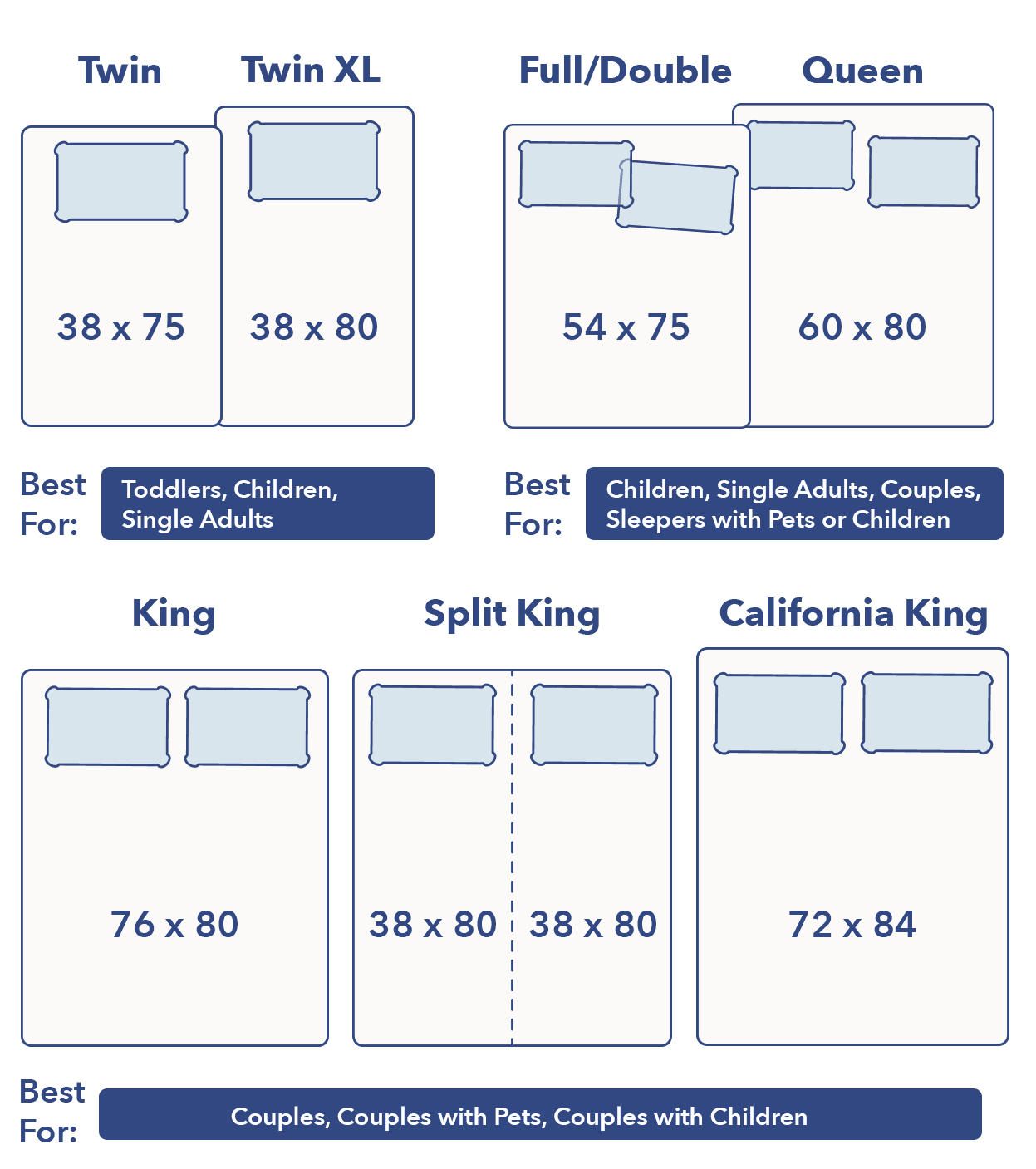
Mattress Sizes Video
Twin Size Bed Dimensions
A Twin size mattress is typically 38” W x 75” L. This is the smallest of the adult-size mattresses. A Twin size mattress would be suitable for a child who has outgrown the toddler bed, a single adult, or those with small bedrooms.
This size is commonly used for daybeds, bunk beds, dorm rooms, or a small guest bedroom.
This is also the smallest mattress for most of the popular online mattress companies. For sleepers tight on budget or space, a Twin size mattress can provide the same luxury feel of a larger mattress, without costing as much or taking up as much room. Check out my top picks for the best twin-size mattress! We’d also like to direct you to the Saatva, which we find to be one of the best innerspring twin-size mattresses out there.
The Saatva’s coil-on-coil construction provides a classic innerspring feel. It's a good option for combo sleepers, who will want to feel free to switch positions and avoid feeling “stuck” in the mattress. It comes in three firmness levels, so you should be able to find one that suits your needs.
We recommend this mattress for the following sleeper types: Financing options are available for this mattress. We were skeptical of buying a mattress on line but it could not have gone any smoother. Anthony answered all of our questions during our many phone conversations. Delivery was prompt and went without a hitch. Best of all the mattress is so comfortable! I haven't had such a good night sleep in years. Highly recommend this.
The Saatva’s coil-on-coil construction provides a classic innerspring feel. It's a good option for combo sleepers, who will want to feel free to switch positions and avoid feeling “stuck” in the mattress. It comes in three firmness levels, so you should be able to find one that suits your needs.
We recommend this mattress for the following sleeper types: Financing options are available for this mattress. We were skeptical of buying a mattress on line but it could not have gone any smoother. Anthony answered all of our questions during our many phone conversations. Delivery was prompt and went without a hitch. Best of all the mattress is so comfortable! I haven't had such a good night sleep in years. Highly recommend this.
The Saatva’s coil-on-coil construction provides a classic innerspring feel. It's a good option for combo sleepers, who will want to feel free to switch positions and avoid feeling “stuck” in the mattress. It comes in three firmness levels, so you should be able to find one that suits your needs.
We recommend this mattress for the following sleeper types: Financing options are available for this mattress. We were skeptical of buying a mattress on line but it could not have gone any smoother. Anthony answered all of our questions during our many phone conversations. Delivery was prompt and went without a hitch. Best of all the mattress is so comfortable! I haven't had such a good night sleep in years. Highly recommend this.
Saatva Mattress
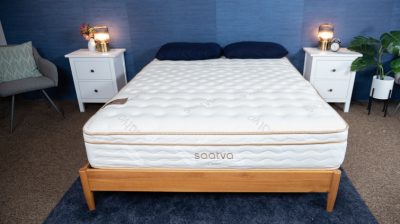
Material
Innerspring
Trial Period
365 nights
Shipping Method
Free white glove delivery
Firmness
Multiple firmness options
Warranty
Lifetime warranty
Price Range
$$$$$
Hot Sleepers
If you often overheat while you sleep, this mattress should help you stay cool.
Back Pain
This bed is perfect for anyone suffering from back pain.
Back Sleeping
Ideal for lightweight, average weight, and heavyweight back sleepers.
Stomach Sleeping
Ideal for lightweight and average weight stomach sleepers.
Financing Options
Saatva Mattress

Material
Innerspring
Warranty
Lifetime warranty
Firmness
Multiple firmness options
Shipping Method
Free white glove delivery
Trial Period
365 nights
Price Range
$$$$$
Hot Sleepers
If you often overheat while you sleep, this mattress should help you stay cool.
Back Pain
This bed is perfect for anyone suffering from back pain.
Back Sleeping
Ideal for lightweight, average weight, and heavyweight back sleepers.
Stomach Sleeping
Ideal for lightweight and average weight stomach sleepers.
Financing Options

Saatva Mattress
Material
Innerspring
Firmness
Multiple firmness options
Trial Period
365 nights
Warranty
Lifetime warranty
Shipping Method
Free white glove delivery
Price Range
$$$$$
Hot Sleepers
If you often overheat while you sleep, this mattress should help you stay cool.
Back Pain
This bed is perfect for anyone suffering from back pain.
Back Sleeping
Ideal for lightweight, average weight, and heavyweight back sleepers.
Stomach Sleeping
Ideal for lightweight and average weight stomach sleepers.
Financing Options
Twin XL Size Bed Dimensions
A Twin XL size mattress is 38” W x 80” L. This mattress is the same width as a traditional twin, but is 5” longer in length. This is great for tall adults who do not have room for a wider bed. Not all sheets or comforters come available in Twin XL, so be sure to double-check and know the difference before shopping for bedding. Learn more about the differences in our Twin vs Twin XL mattress guide.
Can you use two Twin XL mattresses on a King size frame?
The short answer is yes. Two Twin XL mattresses make up the dimensions of one King size mattress. This is a popular strategy for sleeping partners who have very different feel or firmness preferences. Joining two mattresses together on a single frame is also a nice option for sleepers who want to use an adjustable frame. The separate mattresses allow sleepers to sit up or lie back without disrupting their partner.If you do opt for two Twin XL mattresses on a King frame you can either use individual Twin XL bedding sets or a single King size sheet set. We find the twin XL Helix Midnight mattress to be good for both of these purposes.
The Helix Midnight has a medium support level and bounce that will appeal to a wide range of sleep preferences. The Midnight also does an exceptional job of isolating motion, making it a great choice for couples that move around at night.
We recommend this mattress for the following sleeper types: Financing options are available for this mattress. The Helix Midnight has a medium support level and bounce that will appeal to a wide range of sleep preferences. The Midnight also does an exceptional job of isolating motion, making it a great choice for couples that move around at night.
We recommend this mattress for the following sleeper types: Financing options are available for this mattress. The Helix Midnight has a medium support level and bounce that will appeal to a wide range of sleep preferences. The Midnight also does an exceptional job of isolating motion, making it a great choice for couples that move around at night.
We recommend this mattress for the following sleeper types: Financing options are available for this mattress.Helix Midnight Mattress
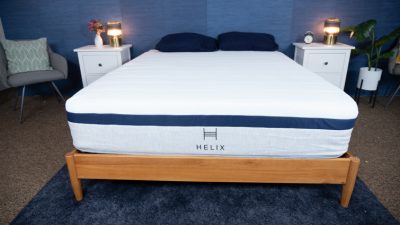
Material
Hybrid
Trial Period
100 nights
Shipping Method
Free shipping
Firmness
Medium-firm: 6.5/10
Warranty
10-year warranty
Price Range
$$$$$
Couples
This bed has great motion isolation so you will not feel your partner tossing and turning at night.
Back Sleeping
Ideal for lightweight and average weight back sleepers.
Side Sleeping
Ideal for lightweight and average weight side sleepers.
Financing Options
Helix Midnight Mattress

Material
Hybrid
Warranty
10-year warranty
Firmness
Medium-firm: 6.5/10
Shipping Method
Free shipping
Trial Period
100 nights
Price Range
$$$$$
Couples
This bed has great motion isolation so you will not feel your partner tossing and turning at night.
Back Sleeping
Ideal for lightweight and average weight back sleepers.
Side Sleeping
Ideal for lightweight and average weight side sleepers.
Financing Options

Helix Midnight Mattress
Material
Hybrid
Firmness
Medium-firm: 6.5/10
Trial Period
100 nights
Warranty
10-year warranty
Shipping Method
Free shipping
Price Range
$$$$$
Couples
This bed has great motion isolation so you will not feel your partner tossing and turning at night.
Back Sleeping
Ideal for lightweight and average weight back sleepers.
Side Sleeping
Ideal for lightweight and average weight side sleepers.
Financing Options
Full Size Bed Dimensions
A Full size mattress is 54”W x 75” L. This size mattress may also be referred to as a “standard double.” For single active sleepers who like to sprawl out or couples who have a small bedroom, a Full size mattress may be suitable. A Full or double size mattress may be a tight squeeze for couples who share the bed with children or pets. See all my top picks for the best full mattresses.
Here are some specs to think about when considering a Full-size mattress:
- For single sleepers, that is 54” of sleeping space.
- For partners, that is 27” of sleeping space per person (11” less than a Twin size mattress).
- A 6’ tall sleeper would have only 3” of extra space if fully extended on this mattress.
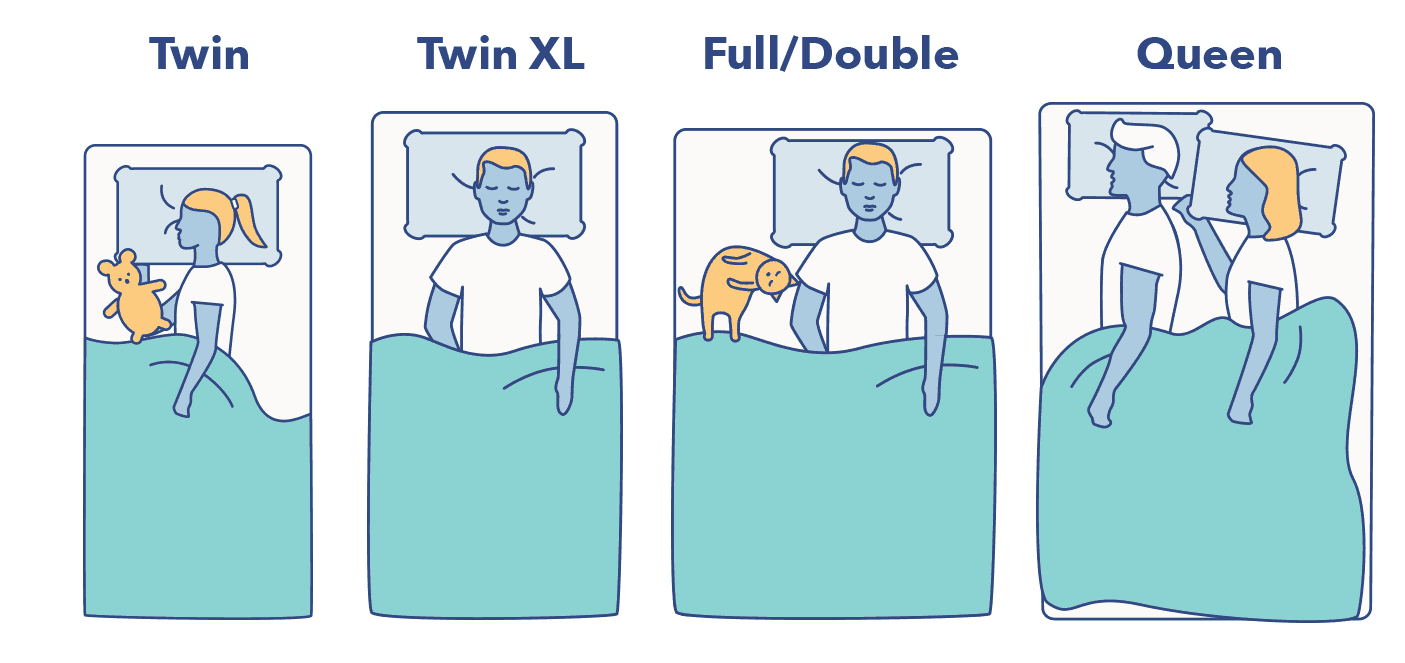
And here’s one of our favorite full-size mattresses, the WinkBed.
The WinkBed is a hybrid mattress that comes in three firmness levels, so most sleepers should find a model that suits their needs. It could also be a good fit for couples, thanks to reinforced edge support.
We recommend this mattress for the following sleeper types: Financing options are available for this mattress. Absolutely the greatest mattress I've ever slept on. It is soft yet firm in the right spots. Quality is on another level. You get what you pay for.
The WinkBed is a hybrid mattress that comes in three firmness levels, so most sleepers should find a model that suits their needs. It could also be a good fit for couples, thanks to reinforced edge support.
We recommend this mattress for the following sleeper types: Financing options are available for this mattress. Absolutely the greatest mattress I've ever slept on. It is soft yet firm in the right spots. Quality is on another level. You get what you pay for.
The WinkBed is a hybrid mattress that comes in three firmness levels, so most sleepers should find a model that suits their needs. It could also be a good fit for couples, thanks to reinforced edge support.
We recommend this mattress for the following sleeper types: Financing options are available for this mattress. Absolutely the greatest mattress I've ever slept on. It is soft yet firm in the right spots. Quality is on another level. You get what you pay for.
WinkBed Mattress

Material
Hybrid
Trial Period
120 nights
Shipping Method
Free shipping
Firmness
Multiple firmness options
Warranty
Lifetime warranty
Price Range
$$$$$
Hot Sleepers
If you often overheat while you sleep, this mattress should help you stay cool.
Back Pain
This bed is perfect for anyone suffering from back pain.
Back Sleeping
Ideal for lightweight and average weight back sleepers.
Side Sleeping
Ideal for lightweight and average weight side sleepers.
Stomach Sleeping
Ideal for average weight stomach sleepers.
Financing Options
WinkBed Mattress

Material
Hybrid
Warranty
Lifetime warranty
Firmness
Multiple firmness options
Shipping Method
Free shipping
Trial Period
120 nights
Price Range
$$$$$
Hot Sleepers
If you often overheat while you sleep, this mattress should help you stay cool.
Back Pain
This bed is perfect for anyone suffering from back pain.
Back Sleeping
Ideal for lightweight and average weight back sleepers.
Side Sleeping
Ideal for lightweight and average weight side sleepers.
Stomach Sleeping
Ideal for average weight stomach sleepers.
Financing Options

WinkBed Mattress
Material
Hybrid
Firmness
Multiple firmness options
Trial Period
120 nights
Warranty
Lifetime warranty
Shipping Method
Free shipping
Price Range
$$$$$
Hot Sleepers
If you often overheat while you sleep, this mattress should help you stay cool.
Back Pain
This bed is perfect for anyone suffering from back pain.
Back Sleeping
Ideal for lightweight and average weight back sleepers.
Side Sleeping
Ideal for lightweight and average weight side sleepers.
Stomach Sleeping
Ideal for average weight stomach sleepers.
Financing Options
Queen Size Bed Dimensions
A Queen size mattress is 60”W x 80”L. This is the most popular mattress size in the United States right now and is a comfortable fit for single active sleepers, couples, and those who may share the bed with children or pets. To comfortably fit a Queen mattress, it is recommended that your bedroom be at least 10’L x 10’W.
Some specs to consider:
- For single sleepers, that is 60” of sleeping space.
- For partners, that is 30” of sleeping space per person (8” less than a Twin size mattress).
- A 6’ tall sleeper would have 8” of extra space if fully extended on this mattress.
- See my top choices for the best queen-size mattresses.
FAQ: Best mattress for couples
If you’re in the market for a queen-size mattress yourself, check out the Bear.
We appreciate the firm and responsive feel of the Bear mattress. Its combination of support and pressure relief makes it an awesome option for anyone struggling with back pain. The Celliant cover also does a great job of keeping the mattress cool.
We recommend this mattress for the following sleeper types: Financing options are available for this mattress. We appreciate the firm and responsive feel of the Bear mattress. Its combination of support and pressure relief makes it an awesome option for anyone struggling with back pain. The Celliant cover also does a great job of keeping the mattress cool.
We recommend this mattress for the following sleeper types: Financing options are available for this mattress. We appreciate the firm and responsive feel of the Bear mattress. Its combination of support and pressure relief makes it an awesome option for anyone struggling with back pain. The Celliant cover also does a great job of keeping the mattress cool.
We recommend this mattress for the following sleeper types: Financing options are available for this mattress.Bear Original Mattress
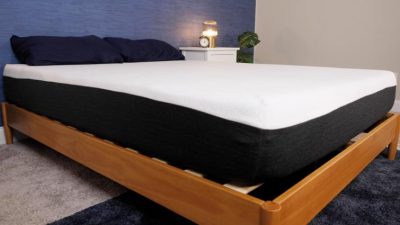
Material
Foam
Trial Period
120 nights
Shipping Method
Free shipping
Firmness
Firm: 7.5/10
Warranty
Lifetime warranty
Price Range
$$$$$
Hot Sleepers
If you often overheat while you sleep, this mattress should help you stay cool.
Back Sleeping
Ideal for lightweight and average weight back sleepers.
Side Sleeping
Ideal for lightweight and average weight side sleepers.
Financing Options
Bear Original Mattress

Material
Foam
Warranty
Lifetime warranty
Firmness
Firm: 7.5/10
Shipping Method
Free shipping
Trial Period
120 nights
Price Range
$$$$$
Hot Sleepers
If you often overheat while you sleep, this mattress should help you stay cool.
Back Sleeping
Ideal for lightweight and average weight back sleepers.
Side Sleeping
Ideal for lightweight and average weight side sleepers.
Financing Options

Bear Original Mattress
Material
Foam
Firmness
Firm: 7.5/10
Trial Period
120 nights
Warranty
Lifetime warranty
Shipping Method
Free shipping
Price Range
$$$$$
Hot Sleepers
If you often overheat while you sleep, this mattress should help you stay cool.
Back Sleeping
Ideal for lightweight and average weight back sleepers.
Side Sleeping
Ideal for lightweight and average weight side sleepers.
Financing Options
King Size Bed Dimensions
A King size mattress is 76”W x 80”L. This mattress is extremely comfortable for single active sleepers as well as couples who share a bed with children or pets. To comfortably fit a King size mattress, it is recommended that your bedroom be at least 12’W x 12’W.
For comparison’s sake, a King size mattress is the same size as two Twin XL mattresses. If you and your partner share a bed, but have very different sleeping preferences, the Split King could be a nice option since it allows each side of the bed to be distinctively different feels. Split King mattresses are also good choices for sleepers who are considering adjustable bed frames.
Consider the following specs before purchasing a King size mattress:
- For single sleepers, it’s 76” of sleeping space.
- For partners, it’s 38” of sleeping space per person (the same width as a Twin size mattress).
- A 6’ tall sleeper would have 8” of extra space if fully extended on this mattress (the same length as a Queen size mattress).
- Check out my picks for the best king size mattresses of the year!
Ready to sleep like a king? Consider the Helix Midnight Luxe, the luxury version of the Helix Midnight.
The Helix Midnight Luxe is a supportive mattress that's great for back sleepers. The Midnight Luxe’s thick comfort layer of memory foam provides plenty of pressure relief and contouring while the zoned coils offer a great deal of support.
We recommend this mattress for the following sleeper types: Financing options are available for this mattress. The Helix Midnight Luxe is a supportive mattress that's great for back sleepers. The Midnight Luxe’s thick comfort layer of memory foam provides plenty of pressure relief and contouring while the zoned coils offer a great deal of support.
We recommend this mattress for the following sleeper types: Financing options are available for this mattress. The Helix Midnight Luxe is a supportive mattress that's great for back sleepers. The Midnight Luxe’s thick comfort layer of memory foam provides plenty of pressure relief and contouring while the zoned coils offer a great deal of support.
We recommend this mattress for the following sleeper types: Financing options are available for this mattress.Helix Midnight Luxe Mattress
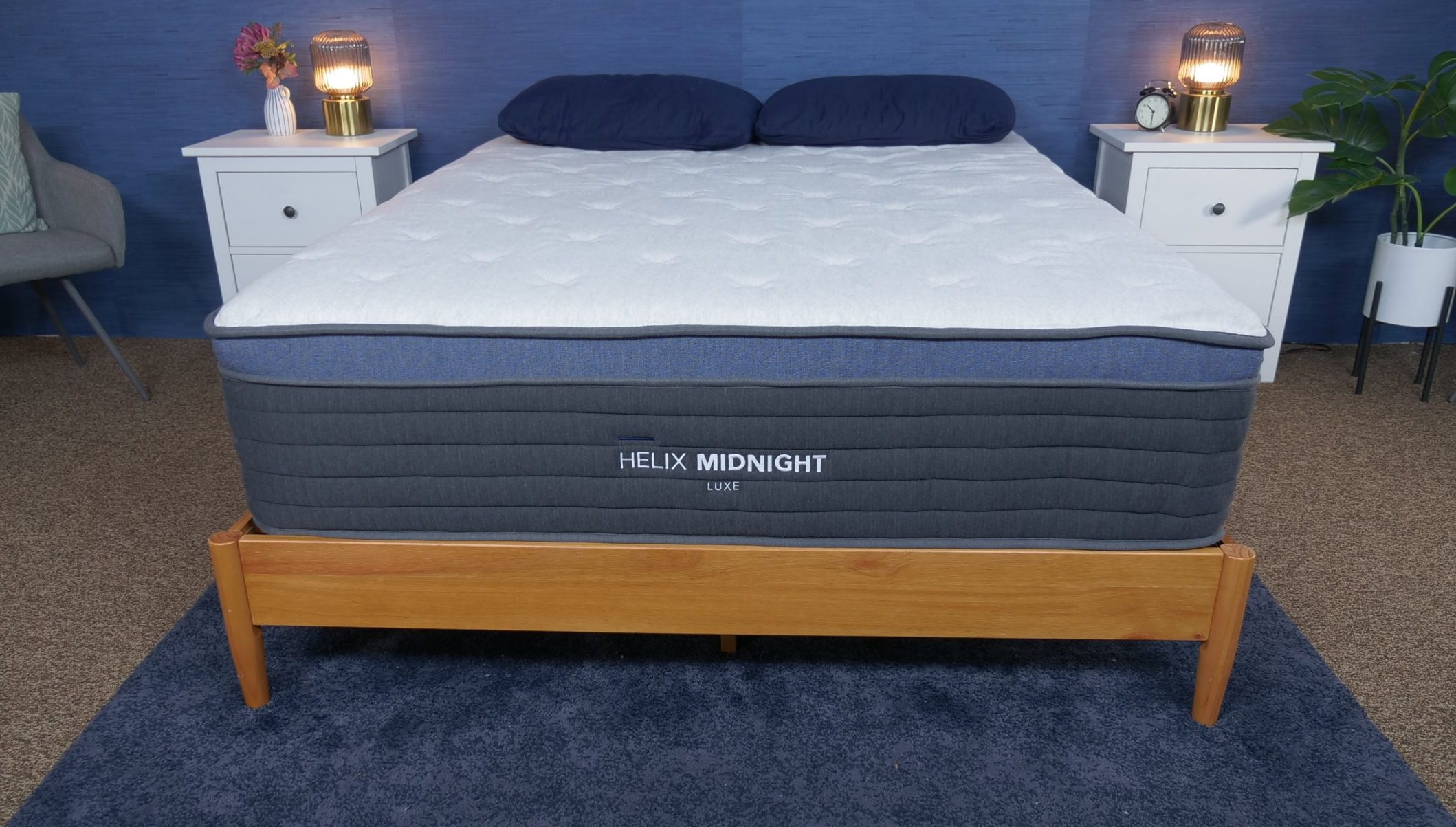
Material
Hybrid
Trial Period
100 nights
Shipping Method
Free shipping
Firmness
Medium-soft: 6/10
Warranty
15-year warranty
Price Range
$$$$$
Back Sleeping
Ideal for average weight and heavyweight back sleepers.
Side Sleeping
Ideal for average weight and heavyweight side sleepers.
Stomach Sleeping
Ideal for lightweight stomach sleepers.
Financing Options
Helix Midnight Luxe Mattress

Material
Hybrid
Warranty
15-year warranty
Firmness
Medium-soft: 6/10
Shipping Method
Free shipping
Trial Period
100 nights
Price Range
$$$$$
Back Sleeping
Ideal for average weight and heavyweight back sleepers.
Side Sleeping
Ideal for average weight and heavyweight side sleepers.
Stomach Sleeping
Ideal for lightweight stomach sleepers.
Financing Options

Helix Midnight Luxe Mattress
Material
Hybrid
Firmness
Medium-soft: 6/10
Trial Period
100 nights
Warranty
15-year warranty
Shipping Method
Free shipping
Price Range
$$$$$
Back Sleeping
Ideal for average weight and heavyweight back sleepers.
Side Sleeping
Ideal for average weight and heavyweight side sleepers.
Stomach Sleeping
Ideal for lightweight stomach sleepers.
Financing Options
Split King Size Bed Dimensions
A Split King size mattress uses two identical-sized mattresses—each 38”W x 80”L—which equals the size of a complete King size mattress. Sleepers who benefit from a Split King bed often have very different sleeping preferences than their partner. The split mattress allows sleepers to have a mattress that is individually right for them, without sacrificing the sleep of their partner.
Some Split King beds are joined at the bottom half of the mattress and only split at the top. This style is more for sleepers who do not have different sleep preferences, since the interior of the mattress is the same throughout. Some couples may also opt for a flippable mattress that offers a different firmness on each side, such as the Layla mattress.
HELP: How to choose a mattress
The benefit of this style of mattress is that, when used on an adjustable frame, each side of the mattress can move independently, allowing sleepers to sit up or lie back without disturbing their partner. The obvious drawback here is finding sheets to fit this style of mattress. These sheets are usually very expensive and may be hard to find.
Ready to start looking at your options? Nectar has a Split King adjustable frame that will allow you and your partner to sleep in your preferred sleeping positions. Make sure to add the adjustable frame to your cart with any mattress purchase:
The original Nectar mattress is a pressure-relieving, yet supportive, bed. It’s made with a thick layer of gel memory foam, which allows the sleeper to really sink into its surface.
We recommend this mattress for the following sleeper types: Financing options are available for this mattress. I dreaded paying for a new mattress but my old one was 15 years old…buying a Nectar was the best choice I could have made! It is so comfortable and didn’t cost an arm and a leg. I would absolutely recommend this mattress to anyone!
The original Nectar mattress is a pressure-relieving, yet supportive, bed. It’s made with a thick layer of gel memory foam, which allows the sleeper to really sink into its surface.
We recommend this mattress for the following sleeper types: Financing options are available for this mattress. I dreaded paying for a new mattress but my old one was 15 years old…buying a Nectar was the best choice I could have made! It is so comfortable and didn’t cost an arm and a leg. I would absolutely recommend this mattress to anyone!
The original Nectar mattress is a pressure-relieving, yet supportive, bed. It’s made with a thick layer of gel memory foam, which allows the sleeper to really sink into its surface.
We recommend this mattress for the following sleeper types: Financing options are available for this mattress. I dreaded paying for a new mattress but my old one was 15 years old…buying a Nectar was the best choice I could have made! It is so comfortable and didn’t cost an arm and a leg. I would absolutely recommend this mattress to anyone!
Nectar Mattress
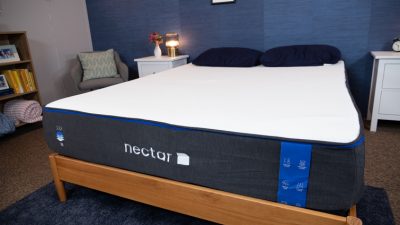
Material
Foam
Trial Period
365 nights
Shipping Method
Free shipping
Firmness
Medium-soft: 6/10
Warranty
Lifetime warranty
Price Range
$$$$$
Joint Pain
This bed is perfect for anyone suffering from joint pain.
Hip Pain
This bed is perfect for anyone suffering from hip pain.
Back Sleeping
Ideal for lightweight and average weight back sleepers.
Side Sleeping
Ideal for lightweight and average weight side sleepers.
Financing Options
Nectar Mattress

Material
Foam
Warranty
Lifetime warranty
Firmness
Medium-soft: 6/10
Shipping Method
Free shipping
Trial Period
365 nights
Price Range
$$$$$
Joint Pain
This bed is perfect for anyone suffering from joint pain.
Hip Pain
This bed is perfect for anyone suffering from hip pain.
Back Sleeping
Ideal for lightweight and average weight back sleepers.
Side Sleeping
Ideal for lightweight and average weight side sleepers.
Financing Options

Nectar Mattress
Material
Foam
Firmness
Medium-soft: 6/10
Trial Period
365 nights
Warranty
Lifetime warranty
Shipping Method
Free shipping
Price Range
$$$$$
Joint Pain
This bed is perfect for anyone suffering from joint pain.
Hip Pain
This bed is perfect for anyone suffering from hip pain.
Back Sleeping
Ideal for lightweight and average weight back sleepers.
Side Sleeping
Ideal for lightweight and average weight side sleepers.
Financing Options
California King Size Bed Dimensions
A California King size mattress is 72”W x 84”. This mattress is great for sleepers who are very tall or just want a little extra length to the mattress. It is extremely spacious for active sleepers or couples who may sleep with children or pets. While the California King mattress is 4” longer in length, it is actually narrower than a standard King size mattress by 4”. To comfortably fit a California King size mattress, it is recommended that your bedroom be at least 12’W x 12’L.
COMPARE: What’s the difference between a California King vs. King?
These specs mean:
- For single sleepers, that is 72” of sleeping space.
- For partners, that is 36” of sleeping space per person (2” less than a Twin size mattress).
- A 6’ tall sleeper would have 12” of extra space if fully extended on this mattress.
- Check out our picks for the best California king mattresses!
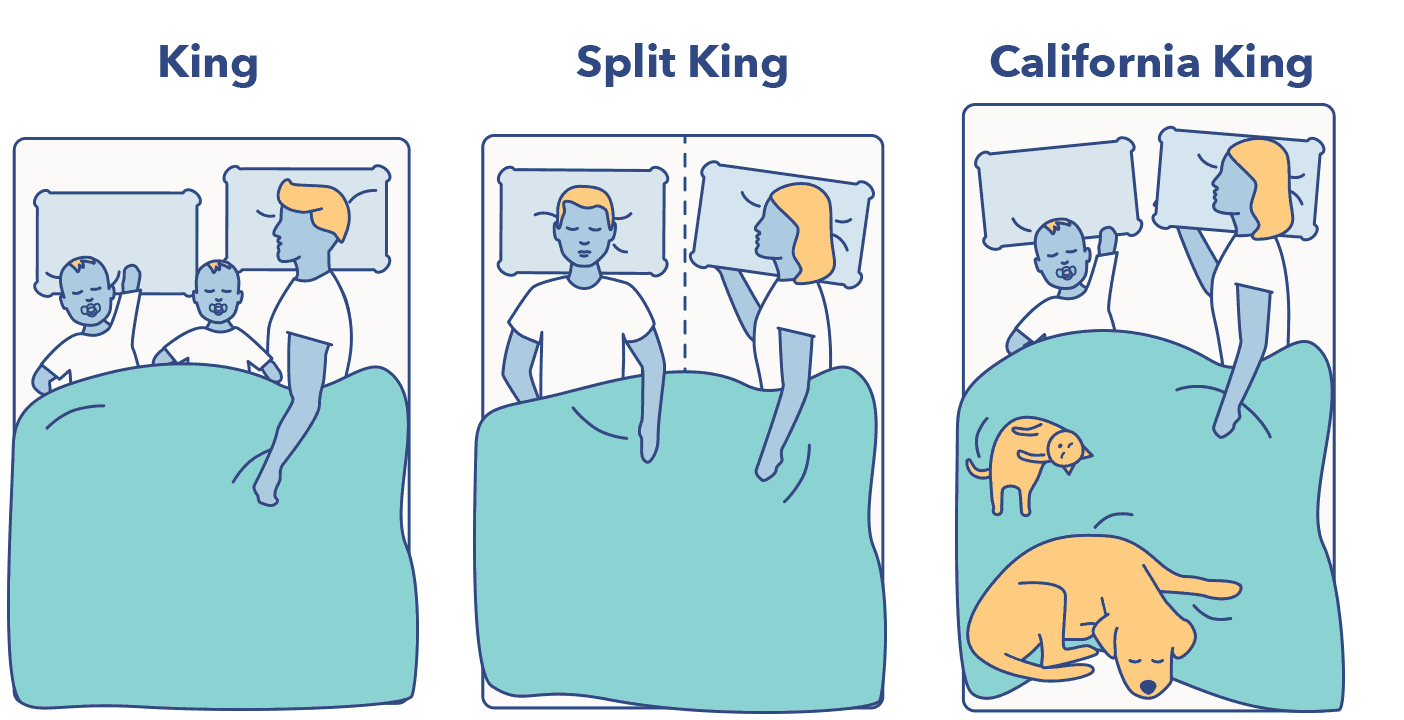
If that sounds like the size for you, DreamCloud offers a luxurious California king. Click below for more details.
The DreamCloud Mattress is a luxury hybrid mattress made with layers of memory foam and pocketed coils. It offers a great combination of support and pressure relief that back sleepers will really enjoy.
We recommend this mattress for the following sleeper types: Financing options are available for this mattress. I have purchased 5 different Dreamcloud mattresses over the years and never once disappointed. Always fast shipping. Fantastic pricing. But by far the best feature is the quality of the Dreamcloud mattress. Also very impressed with the free bedding (sheets) that came with my recent two purchases. Don’t change what you are doing/offering. It’s perfect in every way.
The DreamCloud Mattress is a luxury hybrid mattress made with layers of memory foam and pocketed coils. It offers a great combination of support and pressure relief that back sleepers will really enjoy.
We recommend this mattress for the following sleeper types: Financing options are available for this mattress. I have purchased 5 different Dreamcloud mattresses over the years and never once disappointed. Always fast shipping. Fantastic pricing. But by far the best feature is the quality of the Dreamcloud mattress. Also very impressed with the free bedding (sheets) that came with my recent two purchases. Don’t change what you are doing/offering. It’s perfect in every way.
The DreamCloud Mattress is a luxury hybrid mattress made with layers of memory foam and pocketed coils. It offers a great combination of support and pressure relief that back sleepers will really enjoy.
We recommend this mattress for the following sleeper types: Financing options are available for this mattress. I have purchased 5 different Dreamcloud mattresses over the years and never once disappointed. Always fast shipping. Fantastic pricing. But by far the best feature is the quality of the Dreamcloud mattress. Also very impressed with the free bedding (sheets) that came with my recent two purchases. Don’t change what you are doing/offering. It’s perfect in every way.
DreamCloud Original Mattress
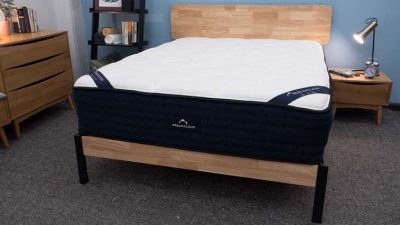
Material
Hybrid
Trial Period
365 nights
Shipping Method
Free shipping
Firmness
Firm: 7/10
Warranty
Lifetime warranty
Price Range
$$$$$
Hot Sleepers
If you often overheat while you sleep, this mattress should help you stay cool.
Seniors
This bed is perfect for senior sleepers.
Back Sleeping
Ideal for average weight back sleepers.
Financing Options
DreamCloud Original Mattress

Material
Hybrid
Warranty
Lifetime warranty
Firmness
Firm: 7/10
Shipping Method
Free shipping
Trial Period
365 nights
Price Range
$$$$$
Hot Sleepers
If you often overheat while you sleep, this mattress should help you stay cool.
Seniors
This bed is perfect for senior sleepers.
Back Sleeping
Ideal for average weight back sleepers.
Financing Options

DreamCloud Original Mattress
Material
Hybrid
Firmness
Firm: 7/10
Trial Period
365 nights
Warranty
Lifetime warranty
Shipping Method
Free shipping
Price Range
$$$$$
Hot Sleepers
If you often overheat while you sleep, this mattress should help you stay cool.
Seniors
This bed is perfect for senior sleepers.
Back Sleeping
Ideal for average weight back sleepers.
Financing Options
What size mattress do I need?
When deciding which mattress is the right fit for you and your space, be sure to consider some of the following factors:
What is the size of your room?
To fit a Queen size bed, your room should be at least 10’x10’. The following scaled images can give you an idea of the footprint a Queen size bed / mattress will take up in both a 10×10′ bedroom and a 12×12′ bedroom.
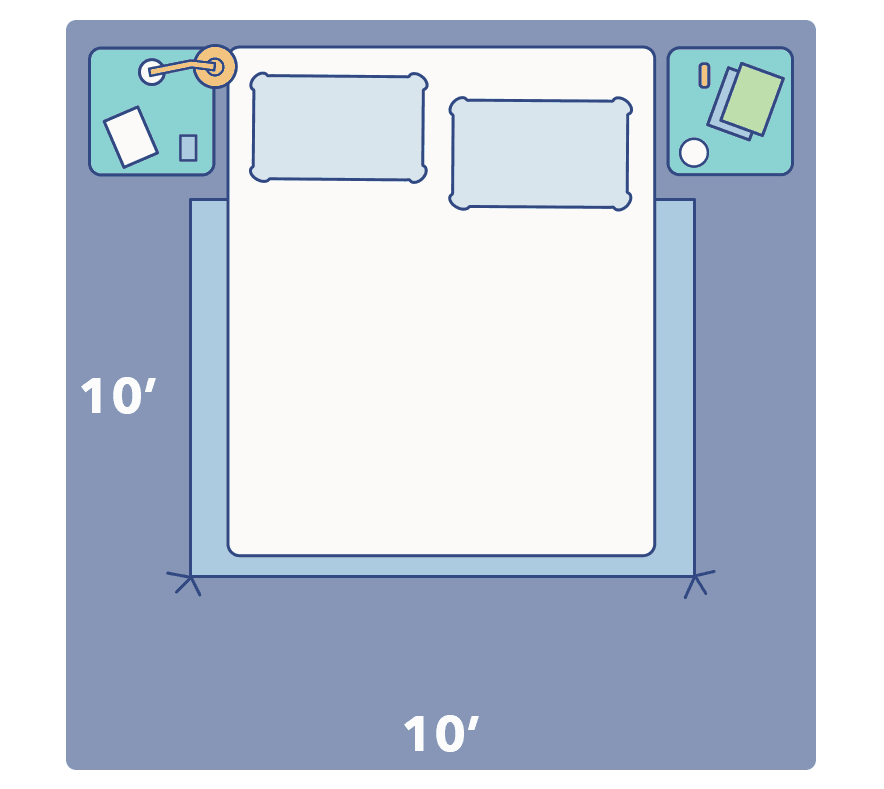
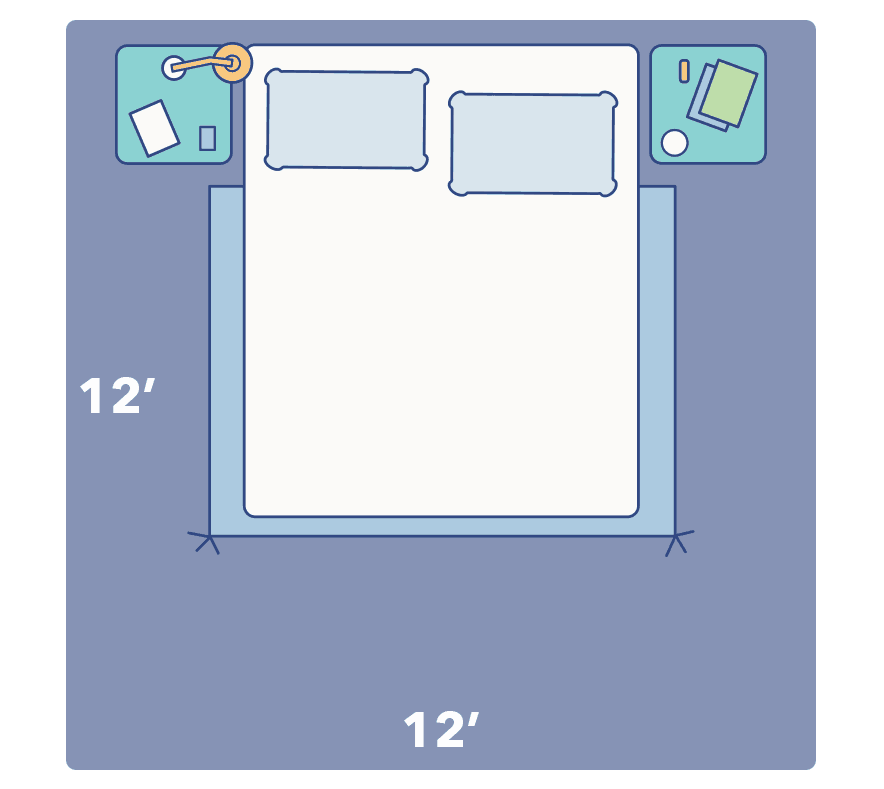
To fit a King size bed or California King size bed, your room should be at least 12’x12’. The two images below will give you a good idea of how large a King size mattress / bed is in relation to a 10×10′ room and 12×12′ room.
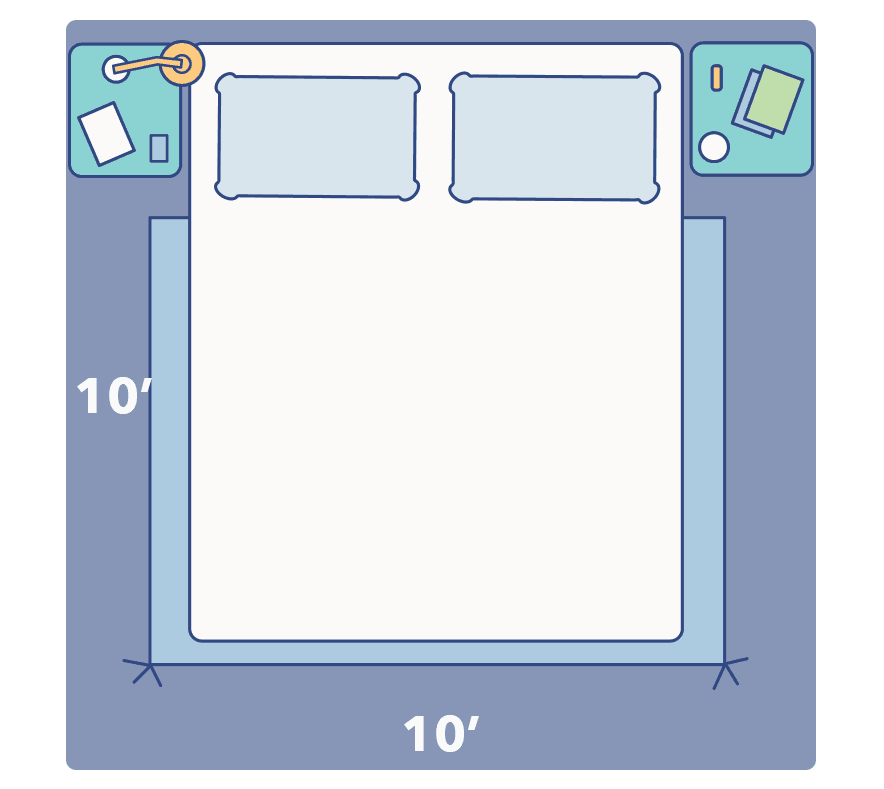
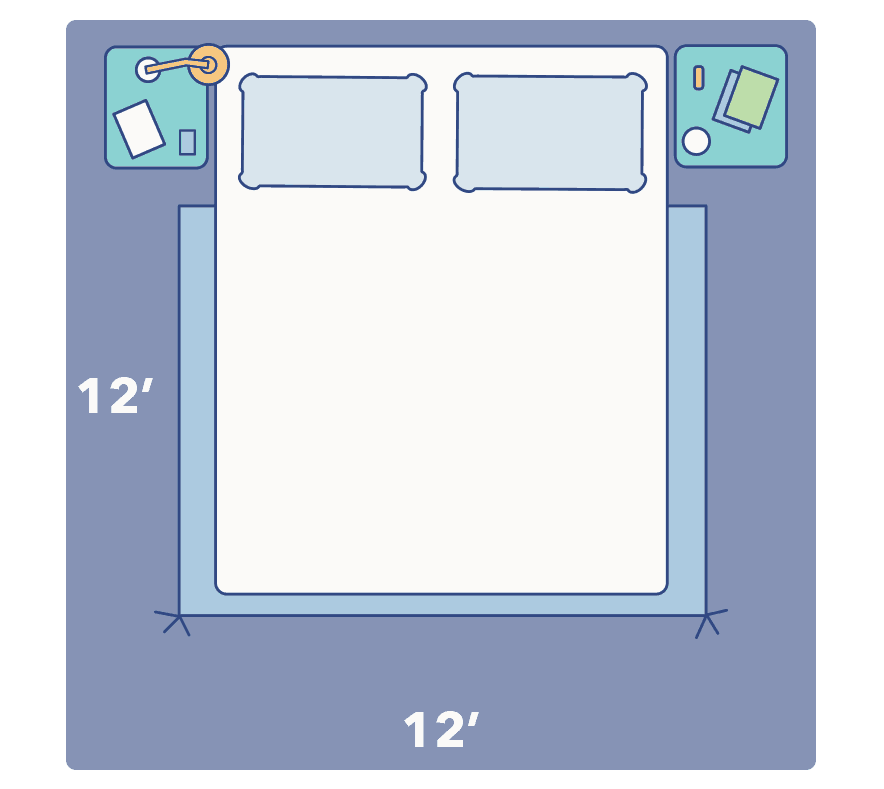
Related: How often should I replace my mattress?
Who will be sleeping in the bed?
Children, depending on age, will likely be most comfortable in the following mattresses:
- Twin bed
- Twin XL
- Full
- Check out our full guide on the best mattresses for kids!
Single adults will likely be most comfortable in the following size mattresses:
- Twin XL
- Full
- Queen
- King
Beds with two adult sleepers will likely be most comfortable in the following size mattresses:
- Queen
- King
- California King
- See our top picks of the best mattress for couples & learn more!
Beds with two adult sleepers and children or pets will likely be most comfortable in the following size mattresses:
- King
- California King
Sleepers who want a mattress that will work with an adjustable frame (to move each side independently) should consider the following mattress sizes:
- (2) Twin XL mattresses
- Split King
- Check out the best mattresses for adjustable bed frames and learn more about what to look for in our buyer’s guide!
Mattress & Bed Dimensions Summary
There are many different styles and mattress/bed sizes out there, and there is no right or wrong answer as to which one is right for you. Considering room size, sleeper size, future growth, and personal preference are all factors that can help you determine which size mattress would be the best fit for you.
